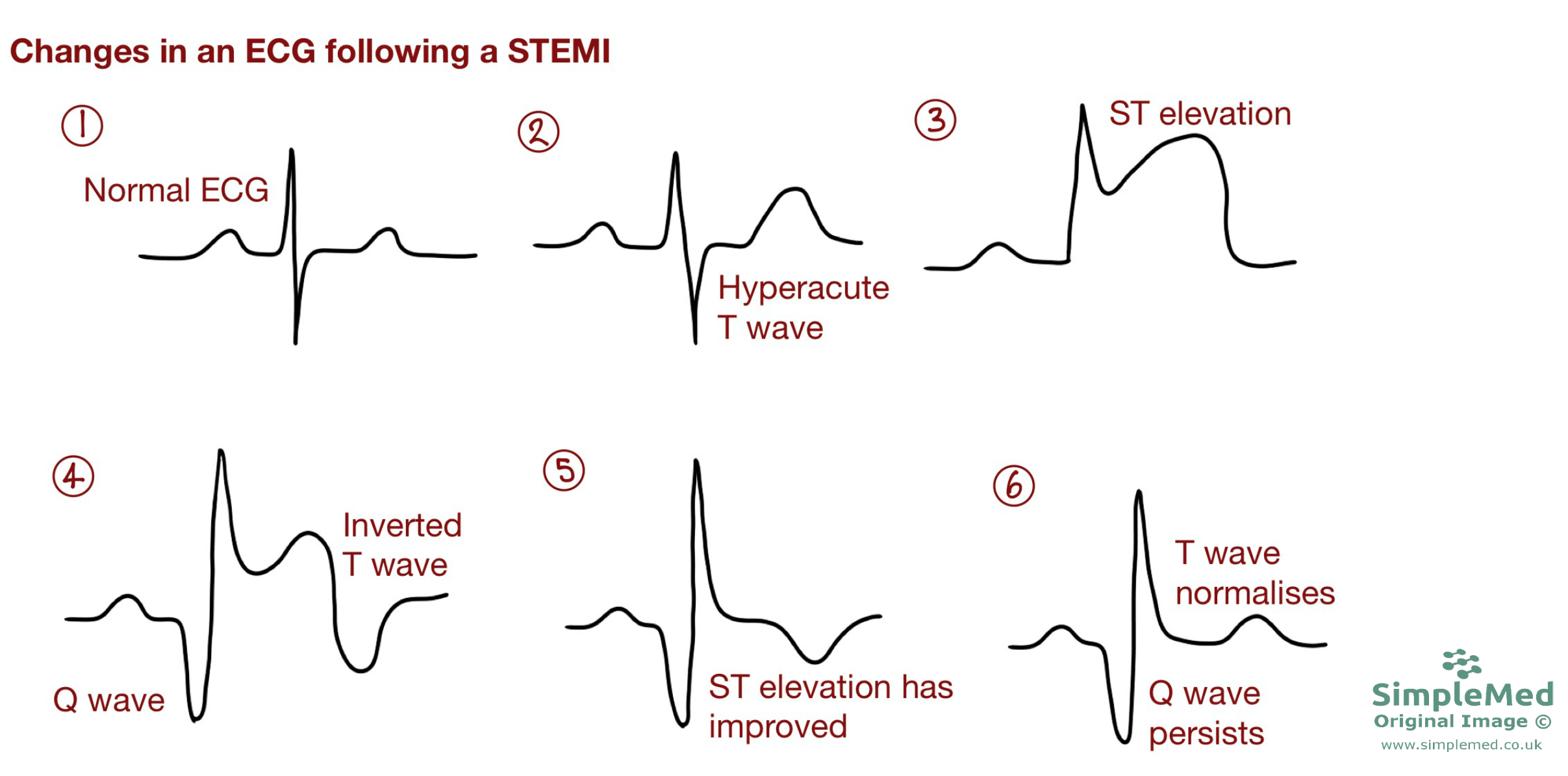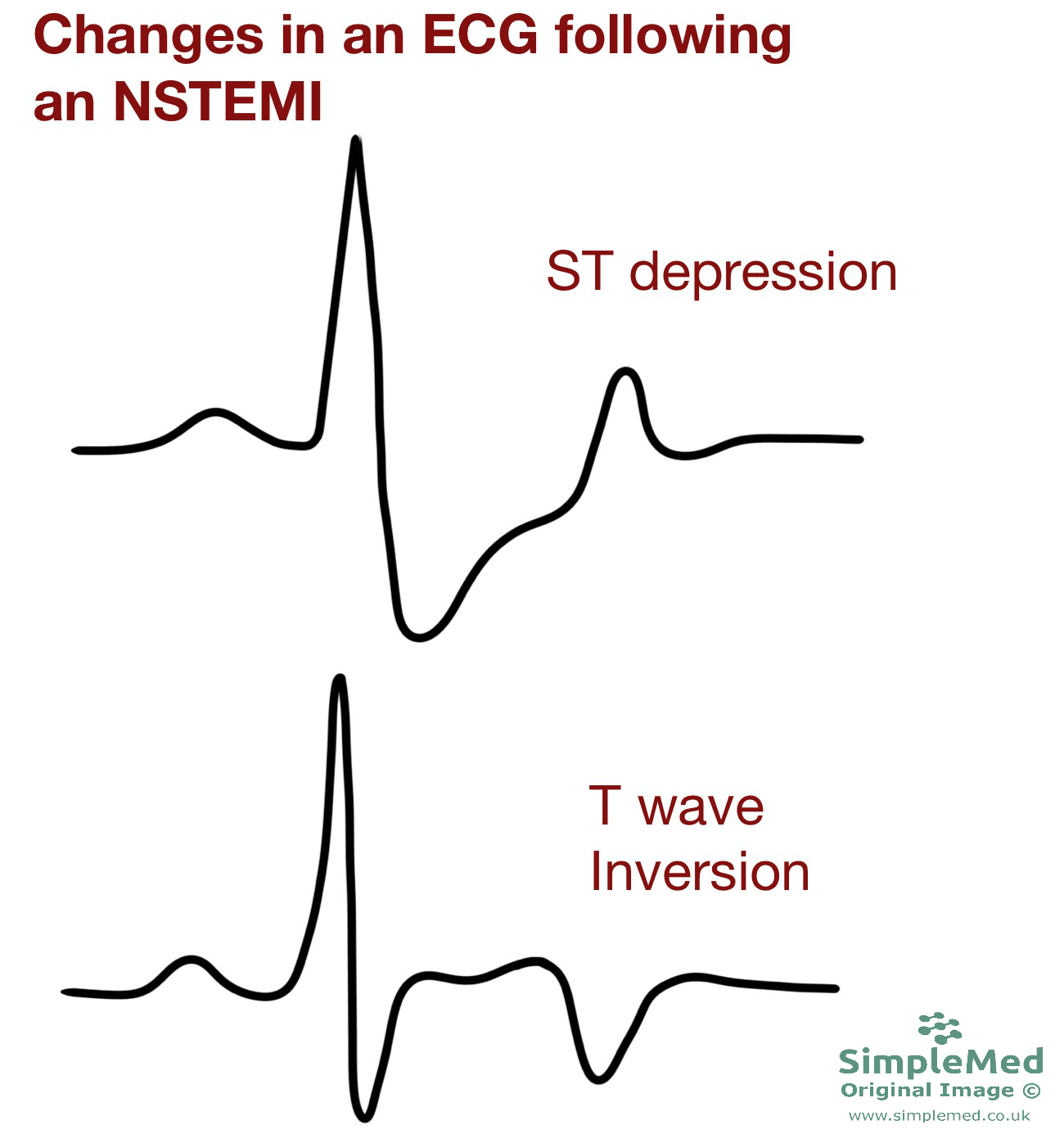By Dr. Thomas Burnell and Bethany Turner
Next Lesson - Haemodynamic Shock
Abstract
- Acute coronary syndromes are caused by partial or full occlusion of coronary arteries leading to ischaemia and infarction of myocardium.
- Acute coronary syndromes include NSTEMI, STEMI, and unstable angina.
- There are multiple causes of chest pain including cardiac, respiratory, GI and musculoskeletal.
- Myocardial infarction can be distinguished form myocardial ischaemia with a troponin assay which indicates myocyte death.
- The types of myocardial infarction can be distinguished by their different appearances on an ECG: STEMI with ST elevation and NSTEMI with ST depression or T-wave inversion.
Core
The term acute coronary syndrome is used to describe a group of conditions that are caused by a sudden reduction in blood flow to the heart - this is most often caused by an atherosclerotic plaque in a coronary artery. Atherosclerotic plaques can partially occlude coronary arteries which may cause ischaemia (restriction of blood supply to tissue reducing perfusion) and further acute occlusion typically by the rupture of the plaque can cause infarction and necrosis of myocardial tissue. Acute coronary syndrome is also known as ischaemic heart disease.
Acute coronary syndromes include:
- Unstable angina
- Non-ST-Elevation Myocardial Infarction (NSTEMI)
- ST-Elevation Myocardial Infarction (STEMI)
Risk factors for acute coronary syndrome can be split into two categories:
- Modifiable risk factors include: smoking, hypertension, dyslipidaemia, diabetes, obesity, sedentary behaviour.
- Non-modifiable risk factors include: male gender, advanced age, family history.
Myocardial infarctions (colloquially known as a heart attack) occur when a coronary artery is suddenly occluded, resulting in infarction (tissue death due to lack of perfusion) of the cardiac tissue that the artery supplies.
Patients will commonly present with intense, dull, central pain at rest that may radiate to the left arm, the neck and jaw. The sympathetic nervous system may be activated in response to the fall in cardiac output, resulting in nausea, generalised pallor and sweating. The patient may also be breathless (dyspnoea).
There are two main types of myocardial infarction:
- STEMI – there is complete coronary artery occlusion causing a transmural (full-thickness) injury to a region of the myocardium. The main changes on an ECG are:
- ST elevation.
- Over time the patient will develop a pathological Q wave on an ECG which will persist after recovery.

Diagram - The changes seen in the ECG of a STEMI patient over time. ST elevation is only present acutely post-MI, before disappearing. A "pathological Q wave" develops and remains permanently after a STEMI
SimpleMed original by Bethany Turner
- NSTEMI – there is partial occlusion of a coronary artery causing a sub-endocardial injury (partial-thickness - the inner layer of the heart wall is spared, an only the outer part of the wall is damaged). The main changes in an ECG are:
- ST segment depression and/or T-wave inversion.

Diagram - The features of an NSTEMI on an ECG
SimpleMed Original by Bethany Turner
In an MI, the dead muscle tissue does not produce an action potential, so the ECG ‘sees through’ the infarcted area and picks up the action potential signal from the opposite side of the heart. This is directed away from the electrode and so causes a pathological Q wave. Therefore, a Q wave shows there has been muscle necrosis.
For a Q wave to be determined as pathological it must:
- Be >1 small square wide
- Be >2 small squares deep
- The depth must be more than ¼ the height of the subsequent R wave
The management of a suspected MI can be remembered by the mnemonic MONA:
- Morphine - to ease the patient's pain.
- Oxygen - the cardiac output may be reduced so oxygen is important to maintain oxygen saturations.
- Nitrates - to cause vasodilation of veins to reduce cardiac return and ease strain on the heart, and to increase the blood flow through the coronary arteries.
- Aspirin - anti-platelet.
Myocardial ischaemia (angina) is when the metabolic demands of the heart are not met, causing pain. This is due to a narrowing the lumen of the coronary arteries typically by athersclerosis. The plaque will be much more stable than in a STEMI or NSTEMI. This results in reduced blood flow to the myocardium. There are two main forms of myocardial ischaemia:
- Stable angina – myocardial ischaemia only occurs when the metabolic demands of the heart are increased e.g. during exercise. The pain is relieved by rest when the metabolic demand of the heart reduces again. Symptoms and signs include:
- Dull, central chest pain on exertion that is relieved by rest.
- Pain may radiate to the shoulder, jaw or left arm.
- An ECG will show ST depression in the leads corresponding to the affected area of the heart during exercise due to the ischaemia of the heart muscle.
- Unstable angina – unstable angina is cardiac pain on exertion and at rest. The pain is more intense and lasts longer than stable angina.
- Patient presents with a dull, central pain at rest which is worse on exertion.
- An ECG will show ST depression and/or T wave inversion in the leads corresponding to the affected area of myocardium.
- Unstable angina is different to NSTEMI as there is no necrosis of myocardium, therefore the troponin is normal as the tissue is in tact.
Angina can be brought on by a number of causes which all result in an increased workload (and so metabolic demand) of the heart:
- Exercise – increased heart rate to meet metabolic demand.
- Stress, emotion and cold weather – all stimulate the sympathetic nervous system which leads to an increased heart rate.
- Eating – eating leads to vasodilation in the arteries to the gastrointestinal tract to aid digestion. This decreases the blood pressure which activates baroreceptors leading to an increased heart rate to restore the blood pressure.
GTN can be given to relieve stable angina, though it does not work in unstable angina. GTN causes vasodilation of veins to decrease the workload of the heart by reducing cardiac return.
Investigations into Acute Coronary Syndromes
The type of acute coronary syndrome a patient presents with (unstable angina, NSTEMI or STEMI) needs to be determined in order to treat the patient appropriately.
To differentiate between myocardial ischaemia and infarction, a troponin assay can be carried out. When myocytes die in infarction, they release troponin I and troponin T into the blood stream which can be detected using a blood test. Troponin can be detected within three hours of an MI and can remain elevated for over two weeks. Troponin will not be present in the blood in patients with unstable angina as there is no myocyte death in this condition, only ischaemia.
To differentiate between a STEMI and NSTEMI, an ECG can be done. As explained above, the main difference between the two on an ECG is that a STEMI will have ST elevation, and an NSTEMI will have either ST depression and/or T wave inversion.
An invasive coronary angiogram can be done to identify the affected coronary artery and see if it has been occluded or not. A stent can also be placed to maintain blood flow through the artery.
Other investigations can be done to assess the patient’s condition:
- Chest X-Ray – is there any pulmonary oedema?
- Urea and electrolytes – to assess kidney function and whether the patient is in cardiogenic shock.
- Bedside cardiac monitoring – to help spot if the patient goes into ventricular tachycardia or fibrillation.
- Echocardiogram – detect valve damage and rate of flow through diseased valves. Will also detect left ventricular impairment which may lead to heart failure.
A patient can experience chest pain for multiple reasons. If the chest pain is cardiac, generally the pain will be dull, poorly localised and worse on exertion. If the chest pain is pleuritic (related to the pleura of the lungs), generally the pain will be sharp, well localised and worse on inspiration.
Some causes of chest pain include (categorised into systems):
- Cardiac:
- Myocardial infarction – STEMI, NSTEMI.
- Myocardial ischaemia – stable or unstable angina.
- Pericarditis – inflammation of the pericardium often due to a viral illness. It causes retrosternal, sharp and localised chest pain, and a pericardial rub may be heard on auscultation of the chest. Saddle-shaped ST elevations may be present on an ECG.
- Aortic dissection – when the inner wall of the aorta tears. Is felt as a sharp, sudden pain from the front to back and the patient will usually lose consciousness and collapse.
- Respiratory:
- Pneumonia – infection and inflammation can irritate the pleura.
- Pleurisy – inflamed pleural layers rub against each other causing pain.
- Pulmonary embolism – acute, well localised, sharp pain due to occlusion of an artery of the pulmonary circulation.
- Musculoskeletal:
- Rib fracture – pain worse on inspiration.
- Costochondritis – inflammation of costal cartilage. Pain is localised.
- Upper gastrointestinal:
- Acid reflux.
- Peptic ulcer disease.
Edited by: Dr. Ben Appleby
- 12873

